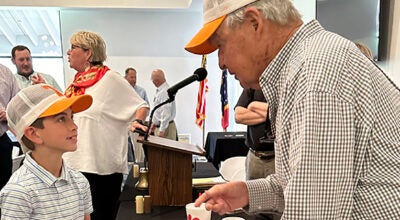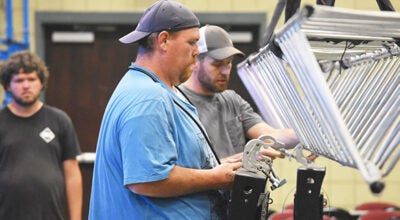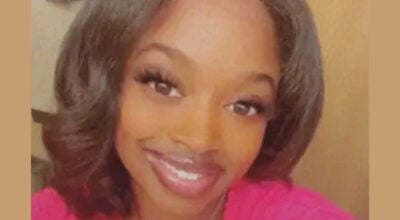Life after loss: Widower recounts wife’s battle against breast cancer
Published 12:00 am Sunday, October 11, 2015

- TOGETHER: Hugh Green visits the grave of his wife, Joe Ann, Friday at Greenlawn Cemetery. Joe Ann Green passed away Nov. 4, 2010.
Every week to 10 days, Hugh Green can been found at his wife’s grave at Greenlawn Cemetery in Vicksburg.
He may have a bucket of soapy water, washing her headstone. He may be operating a weed eater — she loved a neatly trim yard. He even laid new sod on her grave.
Always, he brings a new arrangement of artificial flowers — the only kind the cemetery allows.
“Joe Ann loved flowers,” he said. “I learned from her how to arrange flowers, and I go to Hobby Lobby and get them, arrange them and take them to the cemetery. I know people think that’s silly. They say she’s not there. I say, ‘Look, that’s my time.’ I like to go out there and spend time and talk to her…I don’t like to tell Joe Ann that I miss her because she would scold me if she knew I was grieving for her.”
Green lost the love of his life two days before their 50th wedding anniversary. She was buried two days after their anniversary.
“‘Daddy, you go ahead and count 50 years,’ my son told me,” Green said. “So I do.”
Green and his wife, Joe Ann Blades Green, together fought a battle with breast cancer and its aftermath that spanned more than five years.
Mrs. Green died Nov. 4, 2010. Almost five years later, the pain of losing his wife is still fresh, as evidenced in his voice and in his eyes when he talks about her.
The Greens met through mutual friends. Hugh, originally from Tupelo, had finished college and come to Vicksburg. Joe Ann was raised here. When they met, she was secretary to the president of First National Bank, which he said is now Trustmark. Green retired from the U.S. Army Corps of Engineers Engineering Research and Development Center, where he worked his entire career as a research engineer.
The couple has three sons: Brian, 53, of Vicksburg; Stuart, 51, of Corinth; and Adam, 47, of Vienna, Va. Each son has two children.
The battle begins
In 2005, a routine breast examination in Mrs. Green’s doctor’s office discovered a lump in her breast.
“They did a mammogram and biopsied the lump. We went to a surgeon next. I went back with her then, and we were told it was cancer and you need to have surgery,” Green said. “She took that pretty good, but I didn’t.”
He insisted she have two more opinions — one here and one in Jackson.
“I got a copy of the first doctor’s diagnosis to carry with me,” he said. “I carried this notebook everywhere I went and I recorded everything. She told me, ‘You ask the questions and get the answers,’ so I did ask the questions. Sometimes, the answers were, ‘I simply do not know.’ My excuse was, I have three sons. I have to explain all this to them, which I did. I would write up an email to them and tell them what was going on. But I wanted to know everything.”
The Greens settled on Dr. Phillip Ley, a surgeon who practices in the Jackson area.
“He started over and had his own people do X-rays and what not. He said we needed to have surgery and probably remove the breast because it had gone into the lymph nodes.”
After surgery, Mrs. Green was treated with chemotherapy, followed by radiation, at the Vicksburg Cancer Center.
“The radiation part was no big deal. We went in there and it took just minutes,” Green said. “I’m a research engineer, so I wanted to see that thing, and they gave me a tour.”
Chemotherapy was a different story.
“She never got sick at her stomach, but it affected her strength and her energy. Of course, no two people are alike and no treatments are exactly alike. She took the one they call ‘The Red,’ and of course she lost her hair.
“The funny thing about that, it finally got to the point where she went to the hairdresser and they said, ‘Why don’t we just finish it up.’ It was coming out in gobs, so they just cut it off.
“We were still going to church at that time and she came to me one day and had this scarf on her head. She had this fuzz for hair. She asked me, ‘How do I look?’ I said, ‘You cannot go to church that way. Why, every woman in that church would go shave their heads so they will look like you because you are so beautiful.’”
Mrs. Green did go to church and continued going as long as she could. The Greens attended Crawford Street United Methodist Church. “They supported her so much,” he said.
Green said he talked to his wife about going elsewhere for treatment, but she refused to leave Vicksburg.
“She told me she didn’t want me to go through all this out there and said she wanted to be near her church family and near her community support group,” he said.
Following the breast cancer chemotherapy and radiation, the Greens thought they were on the downhill side of the battle.
‘We thought we’d whipped it’
“We thought we had pretty well whipped that,” he said. But about two years later, Mrs. Green felt a rough patch of skin underneath her hairline. A trip to the dermatologist said the area was malignant and surgically removed the tissue in the area.
“It was not the kind of skin cancer due to the sun,” Green said. “We think that was probably from the cancer that got into her lymph nodes.”
Following surgery, Mrs. Green was treated with radiation.
“We thought we’d whipped it again,” he said.
A couple of years later, they would learn that was not to be the case.
“When you have breast cancer, you go back often and have tests and scans and things like that. A routine X-ray showed she had bone marrow cancer.
“I told the doctor, ‘Show me. What do you mean it’s throughout her body?’ And he showed me the X-rays or MRI or CT scan, whatever it was. It looked like a full body X-ray. He showed it to both of us, and you could see it everywhere.”
The Greens were told the bone marrow cancer was treatable but not curable.
“Of course, being a husband and caregiver, we never gave up. We never threw in the towel. We never did,” Green said.
In January 2010, she began a new chemotherapy treatment for the bone marrow cancer.
“I asked the doctor what we were looking at. He said it could be two years or it could be 10 years. They really don’t know,” he said. “I never got angry with anyone. I always had confidence in the doctors and I always asked a lot of questions.
“You do get angry with yourself. We were both Christians, but I prayed that I would get the cancer, not her. I prayed that I would get it, and my answer was, ‘You’re not man enough. You can’t handle it.’ What she went through was tough. She was so strong. I never heard her complain. I never heard her fuss or blame anyone or talk negative. She was always positive,” Green said.
He said her church family at Crawford Street supported her through difficult times.
“My preacher came out and anointed her with oil. He asked if he could do it, and I said fine.
“One Saturday afternoon, they had a shower at the church and, of course, Joe Ann couldn’t go. I got a knock on the door at about 4 o’clock and here were these three or four women with all the food left from the shower, and it was a lot of stuff. I told them they looked to me like angels who showed up to help feed me,” Green said.
The Greens were a close couple, he said, but the battle with cancer made them closer.
“I did all the cooking for a good while. Joe Ann could sit up and tell me what to do, and I learned to cook. All of this made us closer. We never had any marital problems, we never did.”
‘I am tired, and I want to stop’
“She took the chemo, which kind of knocks you out for a couple of days. They put poison in your body. About the time you get to feeling better, it’s time for another round. And in between rounds you take blood tests and get shots — it’s constant going, up and down, up and down,” Green said.
“There came a time when she told me, ‘I am tired of going out there and taking chemo. I am tired and want to stop.’ I kind of thought the same thing for her, but I didn’t say anything. Then, the same day, we went to the doctor and he told us he thought it was time we think about hospice.
“I was ready to stop what she was going through. She was feeling bad, and I thought hospice care would give her a break, which we could still whip it, but she’d start feeling better first. We never did give up,” he said.
The Greens made the decision to go from the aggressive chemotherapy treatment to the comfort care of hospice.
“They don’t try to cure anything. They tried to keep her comfortable. They were very supportive. For the last month or six weeks, I didn’t go anywhere except to Walmart. That’s where I could get her anything she needed — prescriptions, food, supplies — whatever she needed. Hospice arranged for a volunteer to come and be with her for an hour so I could go to the store.”
One day near the end, a hospice worker advised Green to call his sons and ask them to come home that week.
“She told me I needed to get them here in the next three days. I said, ‘Look, I’m with her 24 hours a day. She’s not there yet.’ But they kept urging me to call them. I finally did. When we were all here — my sons and daughters in law — the nurse told me we had to go in and tell her it was OK to go. I said, ‘I can’t do that. I just can’t,’ but the nurse told me she was suffering and she was holding on for me. So, we did tell her that,” Green said. “She lasted 24 more hours.”
Life goes on
“As Christians, we spend a lot of time on Earth preparing for the hereafter. God called her because she was prepared and deserving,” Green said.
Today, Green keeps busy as a very active volunteer at his church and community groups River City Rescue Mission, Storehouse Community Food Pantry, Good Shepherd Community Center and Meals on Wheels.
“Thursday’s my only day for yard work,” he said.
His advice for other husbands who may be fighting a similar battle with their wives is get active in a church, follow your doctor’s advice, don’t listen to friends and family who tell you to do this and that unless it’s approved by the AMA or FDA and, finally, hang in there.
“I would advise married couples to go where you can every chance you get because you’re investing in memories,” Green said. “We did that. We took cruises. We went on five different tours of the U.S, including Hawaii and Alaska. We went to England, Scotland, Honduras and Canada. She loved flowers and everywhere we went, she managed to find a nice flower garden.”





